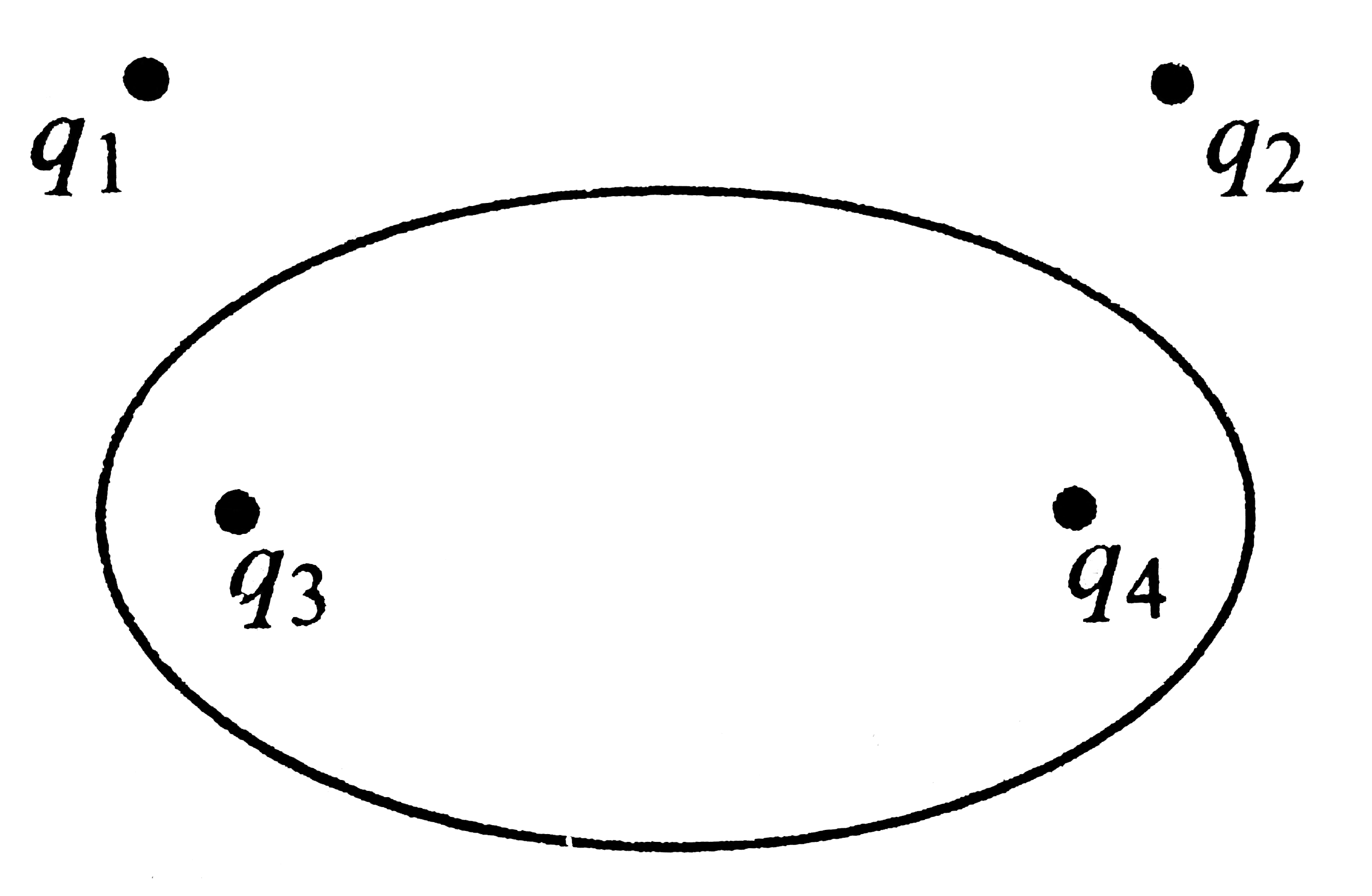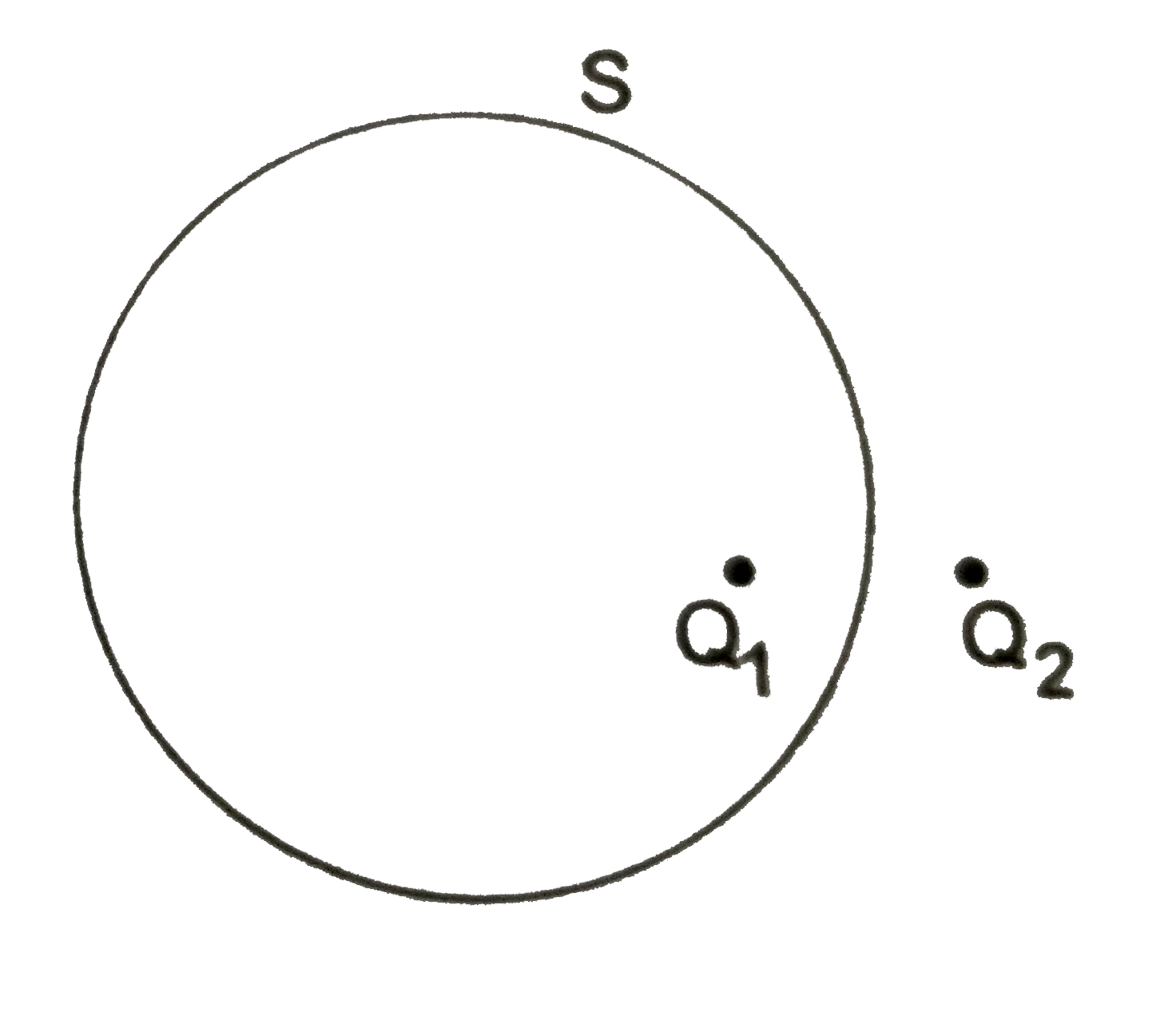Charges Q1andQ2 lie inside and outside, respectively, of a closed surface S. Let E be the field at any point on S and ϕ be the flux of E over S. Solution in Gujrati
The correct Answer is:A, B, C
Electric flux depends on the total charge enclosed by the closed surface S. Hence flux is related with charge Q1. Electric field at a point is the vector sum of the all electric field intensities due to all charges.
Topper's Solved these Questions
- MISCELLANEOUSBOOK - ALLEN CHAPTER - MISCELLANEOUSEXERCISE - Exercise-03
1 Videos
- MISCELLANEOUSBOOK - ALLEN CHAPTER - MISCELLANEOUSEXERCISE - Exercise-04
1 Videos
- MISCELLANEOUSBOOK - ALLEN CHAPTER - MISCELLANEOUSEXERCISE - Exersice -05(B)
20 Videos
- KINEMATICS (MOTION ALONG A STRAIGHT LINE AND MOTION IN A PLANE)BOOK - ALLEN CHAPTER - KINEMATICS (MOTION ALONG A STRAIGHT LINE AND MOTION IN A PLANE)EXERCISE - BEGINNER S BOX-7
8 Videos
- PHYSICAL WORLD, UNITS AND DIMENSIONS & ERRORS IN MEASUREMENT BOOK - ALLEN CHAPTER - PHYSICAL WORLD, UNITS AND DIMENSIONS & ERRORS IN MEASUREMENT EXERCISE - EXERCISE-IV
7 Videos
Similar Questions
Two parallel metallic plates have surface charge densities σ1 and σ2 as shown in figure.

Column-IColumn-II(A)If σ1+σ2=0(p)Electric field in region III is towards right(B)Ifσ1+σ2>0(q)Electric field in region I is zero(C)If σ1+σ2<0(r)Electric field in region I is towards roght(s)Nothing can be said
View SolutionIn each situation of Column-I two elelctric dipoles having moments →p1 and →p1 of same magnitude (that is ,p1=p2) are placed on x-axis symmetrically about origin in different orientations as shown. In column-II certain inferences are drawn for these two dipoles. Then match the different orientations of dipole in column-I with the corresponding result in column-II.

View SolutionPlanck's constant has dimensions …………….
View SolutionA football player kicks a ball at an angle of 30∘ with an initial speed of 20 m/s. Assuming that the ball travels in a vertical plane, calculate (a) the time at which the ball reaches the highest point (b) the maximum height reached (c) the horizontal range of the ball (d) the time for which the ball is in the air, (g=10m/s2)
View SolutionAssertion : Gravitational forces do not depend on the medium between the masses.
Reason : Mediating particle responsible for gravitational force is graviton.
View SolutionFigure shows four charges q1,q2,q3,andq4 fixed is space. Then the total flux of the electric field through a closed surface S, due to all the charges, is

View SolutionCharges Q1andQ2 lie inside and outside, respectively, of a closed surface S. Let E be the field at any point on S and ϕ be the flux of E over S.
View SolutionThe suface integral of electrostatic field vec(E) produced by any sources over any closed surface S enclosing a volume V in vacumm, i.e., total electric flux over the closed S in vacumm is 1//in_(0) times the total charge (Q) contained inside S, i.e, phi_(E) = oint vec(E). vec(ds) = (Q)/(in_(0)) The charge inside S may be point charges or even continous charge distributions. There is no contribution to total electric flux from the charges outside S. Further, the location at Q inside S does not affect the value of surface integral. Read the above passage and answer the following questions : (i) what are the SI unit and dimensions of electric flux ? (ii) A closed surface in vacumm encloses charge -q, + 3q and +5q . Another charge +4q lies outside the surface. What is total electric flux over the surface ? (iii) A point charge q lies inside a spherical of radius r. How will the electric flux be affected if radius of the sphere is doubled ? (iv) What values of life do yo+-earn from the theorem ?
View Solutionचित्र 2.3 में प्रदर्शित किसी बंद तल S के भीतर और बहार विधुत आवेश क्रमशः Q1 और Q2 स्थित है। यदि बंद तल S के किसी बिन्दु पर विधुत-क्षेत्र का परिणाम E हो तथा तल से गुजरनेवाले नेट विधुत-फ्लक्स ϕ हो तब

View Solutionointvec(E).dvec(s)= Electric flux through a closed surface 's' Match the column : {:(,"Column I",,"Column II"),((A),"The value of"oint vec(E).dvec(s) " is affected by ",(p),+ve " charge inside 's'"),((B),"Electric field at a point inside 's' is affected by" ,(q),-ve "charge inside 's'"),((C ),"Electric field at a point outside 's' is affected by ",(r ),+ve" charge outside 's'"),((D),"Electric field at a point at the surface of 's' is affected by ",(s),"-ve charge outside 's'"),(,,(t),"Outside charges but very far away from 's'"):}
View SolutionThree point charges are placed as shown in the figure. S is a gaussian surface phi is the net flux passing through surface A and E be the electric field at point P on the surface, then
View SolutionLet S be an imaginary closed surface enclosing mass m. Let d→S be an element of area on S, the direction of d→S being outward from S. Let →E be the gravitational intensity at d→S. We define ϕ=∮sE⋅dS, the integration being carried out over the entire surface S.
View SolutionTwo point charges q_1 and q_2 are fixed at a separation of 20 cm. Locate the point(s) on the line joining the charges where the net electric field intensity is zero. (i) q_1=+2muC and q_2=-4 muC (ii) q_1=+2muC and q_2=-2muC (iii) q_1=+2muC and q_2=+4muC
View SolutionIf charge q1 and q2 lies inside and outside respectively of a closed surface S. Let E be the electric field at any point on S and ϕ be the electric flux over S. Select the incorrect option.
View Solutionबंद सतह S के अन्दर एवं बाहर क्रमशः आवेश Q1 एवं Q2 स्थित है। यदि S पर किसी बिन्दु पर क्षैत्र E एवं S पर E का फ्लक्स ϕ हो तो।
View SolutionCharges Q_1 and Q_2 lie inside and outside, respectively, of a closed surface S. Let E be the field at any point on S and phi be the flux of E over S.
View Solution
